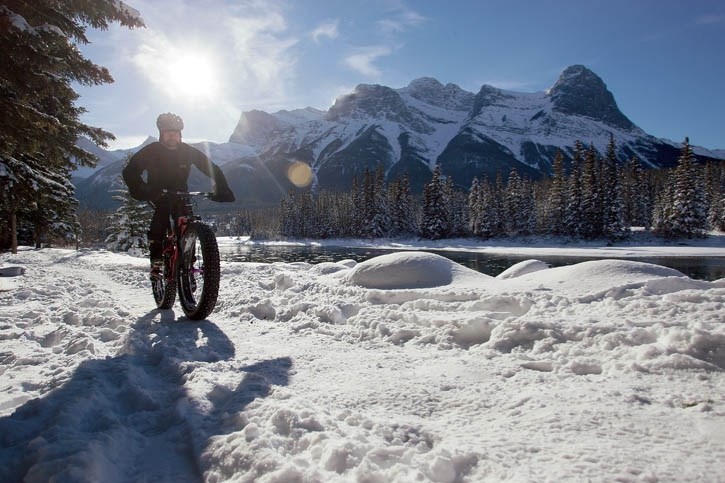The Canmore Nordic Centre has altered its fat bike policy for the 2015-16 season, restricting the bikes to ungroomed single and double track trails.
“This is a sport that’s growing and we wanted to designate some trails for fat biking,” said Alberta Parks spokeswoman Jill Sawyer. “Last year, you could access all of the groomed trails at the Nordic Centre on a fat bike, but they had to pay the trail fee. This year, there is no fee for fat biking, but they must stay on ungroomed trails.”
Fat bikes have extra-wide tires (3.7-inches wide) and a thick, sturdy frame that allows them to handle snowy conditions. Nordic Centre staff said there were several reasons for the change.
“If you’ve got people riding on groomed trails, you have to make sure they stay off the classic track. Because people are skating, the trails can get really crowded. This gives the riders their own space. We didn’t get a lot of feedback, but we had a few people who voiced complaints,” Sawyer said.
The Nordic Centre is specifically promoting EKG East, EKG, Blue Coal Chutes, Long Road to Ruin, Orchid, Canmore Trail and Georgetown Trail as designated fat bike trails.
Regular mountain bikes are not permitted on these trails, as the Nordic Centre says the narrow tires are more likely to leave deep ruts in groomed trails. All trails above EKG East are closed from Dec. 1 to June 15.
The Nordic Centre won’t pack down the fat bike trails, noting several of the single track trails are too narrow for a snowmobile to navigate. Fat bikes aren’t allowed on any trails past the meadow, severing the connection to the Rundle Riverside path to Banff, although next year they will be allowed on the new long line trail. When fat bike trails cross ski trails, fat bikers must yield to skiers.
Sawyer said the Nordic Centre is looking for feedback on the change, as the policy will likely change over time.
“We are certainly always looking for feedback from riders and skiers, about how they interact. This seemed like a good way to try it,” Sawyer said.
Michael Roycroft said the Nordic Centre first began debating the fat bike question four years ago, and by separating fat bikers from skiers, both groups could benefit.
“Over the four years, we received feedback for and against fat bikes on groomed trails. With discussions with the Canmore Nordic Centre advisory group, the message we were hearing is fat bikers prefer single track trails. The vast majority of skiers had no issues with fat bikes, although some were brought to our attention,” Roycroft said.
New fat biking signs have popped up on many trails at the Nordic Centre, as there are currently about 25 kilometres of trails for fat bikes.
“At this point, we will monitor the activity and determine as the season goes along if additional grooming may be required. It will be a challenge getting snowmobiles through some of our single track trails. We might instead do some minor packing in the middle of the trail instead. Given that most of the single track is in the trees, the snow depth will be less,” Roycroft said.
In Kananaskis Country, Alberta Parks wants to promote more fat bike usage, but again keep them off cross-country ski trails. Snowshoe trails are all open to fat bikes, including the new Lower Ribbon Creek Trail and the still-unfinished High Rockies Trail.
“Basically, if the trail is groomed for cross-country skiing, we’d prefer fat bikes not use it,” Roycroft said.
Sawyer said fat bikes are opening up more terrain across Kananaskis Country, and the province must respond quickly.
“There are discussions about the High Rockies Trail. People will be biking up there. That is an area that has some avalanche danger and we will be putting signs up there. The High Rockies Trail wasn’t planned to be a winter access trail, but we’ve had people biking on it already,” Sawyer said.
“We are finding more fat bikers are getting into avalanche terrain who aren’t prepped for it. People see these trails as free game and they don’t take the same safety precautions as a backcountry skier would.”
Rebound Cycle General Manager Ryan Draper said he expects the fat bike community will welcome the chance to have their own trails.
“It’s going to have a minimal effect. It’s something we proposed four years ago, to create a division between the skiers and fat bikers, to avoid any possible conflict. Fat biking on single track is a lot more ideal. It’s in the trees, it tends to be significantly warmer, and its on trails mountain bikers are familiar with,” Draper said.
As for grooming, Draper said the fat bikers won’t really need a snowmobile to go over the trails, although he said it might be a nice option on some of the double track.
“Single track is never where we look for packed snow. Somewhere more like the Georgetown Climb would be a better option. Because it’s a long, uphill climb, if it’s hard-packed, that would be nice,” Draper said. “A lot of walkers also use that trail.”
He does caution first time fat bikers may be tempted to ride on groomed ski trails.
“The only place it might have a small impact is on the first time fat biker, when people don’t know the code of conduct or are ignorant to it. They may take the path of least resistence, which may have them stray off onto ski trails,” Draper said.
Rebound Cycle is hosting a fat bike information night on Dec. 3 at 5 p.m. to go over the new guidelines, provide information on the sport, techniques and tips for planning big fat bike adventures.




